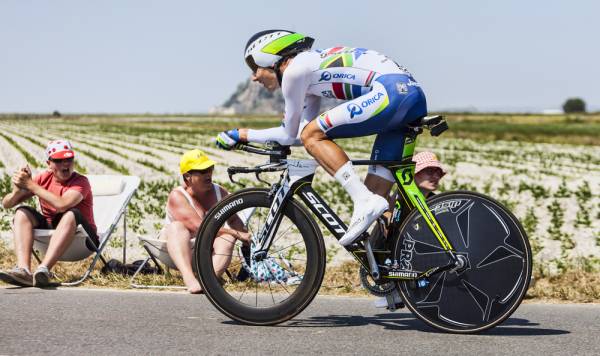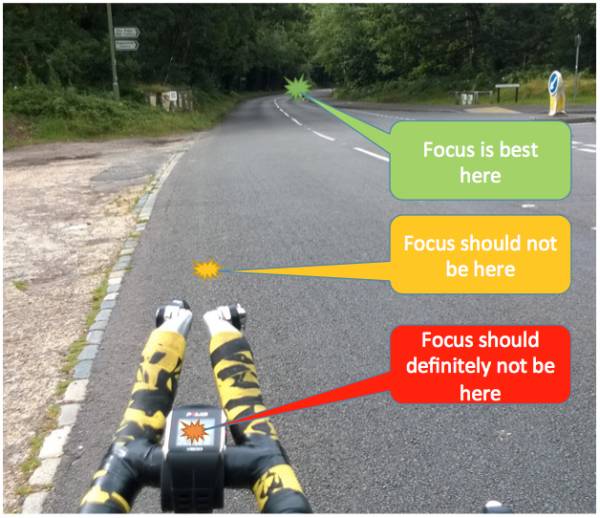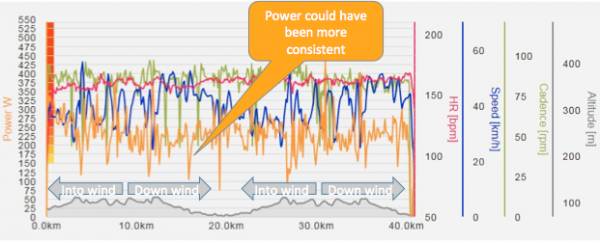I think it’s always worth reviewing how you did after an event to see how you might improve. How else can you determine what worked and what didn’t work? Or what course to follow from here forward for different results?
This is how I prepared for a 25-mile time trial last weekend and what I found made a difference.
Pre-ride Preparation
As with all events, I usually have some strategy in mind for how I am going to tackle it. I knew the course for this event quite well, so I didn’t need to look up the route in advance. If I were not familiar with the course, I would have investigated the route, the travel arrangements, the location of the headquarters, and the start and finish. In particular, I spend time in advance looking into the location and grade of the hills, where to recover on downhills, major waypoints, prevailing wind direction, and any awkward-looking junctions.
Knowing all the details of the time-trial course is key.
Since I am a numbers type of person, I know my typical threshold figures. As this was a 25-mile event, I planned to ride at near threshold pace for about an hour. I have been doing a lot of swimming recently and spending less time on my bike, so I expected my threshold to be less than it was two or three weeks ago. It only takes a couple of weeks off to have a measurable reduction in performance.1
The outward section of this course is usually heading into the prevailing wind, while you return with the wind. This meant I would need to put a bit more effort into the outbound section to make up time as I would have the wind behind me on the return. It is harder to keep the power up with a strong wind behind you. A quick weather forecast check showed that the day was expected to be dry with the wind in the usual direction, but quite gusty.
One of the golden rules of any sport is not to change anything right before an event. But I had to make an exception. Last year on this event, I used some time-trial bars in a lower position to reduce my aerodynamic drag. Since I am a lot larger than my cycle, making changes to my position is more likely to affect my result than any of the latest accessories. If I were a full-time professional and seconds mattered, then I might take a different view.
“In particular, I spend time in advance looking into the location and grade of the hills, where to recover on downhills, major waypoints, prevailing wind direction, and any awkward-looking junctions.”
Recently, I have found that the more aggressive riding position of these time-trial bars made my neck uncomfortable. Although it was sustainable for a shorter ten-mile event, it was not going to be sustainable for 25 miles. And sitting up to relieve the resulting discomfort was going to negate any aerodynamic benefit of the lower bars.
Fortunately, I had another pair of bars available that were not quite so aggressive. The elbow pads on these are four centimeters higher. Although my position would not be quite so good, I was banking on it being a much more comfortable experience. Being able to maintain the tucked position for the entire event should garner a shorter time overall, as opposed to sitting up from time to time to relieve discomfort.

As part of my preparation, I check the security of all my cycle fittings and the condition of the tires. Any tire damage would mean a change of tire. A check of the bar position on the turbo was also required.
Finally, the night before the event, I check that I have my kit ready and any electrical gadget I am taking with me has the right settings, good batteries, or is on charge. I don’t like to fiddle with things last minute or during the race so I usually set up a computer to automatically time the event distance and have the essential figures on display like power or heart rate, distance, and time.
Race Day
When race day arrives, my morning routine involves a large glass of water and an easily digestible breakfast such as oats at least two hours before my race time. For an afternoon event, I have a light lunch two to three hours before my time.
The water ensures I am well hydrated. Poor hydration can lead to reduced performance and even be dangerous on long events in hot weather. Blood plasma volume is critically dependent upon good hydration and your blood has to shunt the nutrients and oxygen to your hard-working muscles.
Having signed on and collected my race number. It’s then time for a warm up via either the turbo trainer or a short ride near the race start as conditions allow. Generally, I prefer to use the turbo to avoid any chance of a puncture. It also means I can make any last minute choices like putting on a jacket or having another drink.

When racing, I ensure my point of focus is where I am actually going. This might sound obvious, but it’s easy to let your point of focus be just in front of the bike, or even watching the numbers on your computer, when you should be looking down the road. This is not just a safety issue. I find it helps to look a long way ahead, down the road and through the next bend. This helps to avoid distractions and mentally leads you through the race. With a short-term focus, the whole event seems more difficult.
Post Event Review
The day turned out as expected, dry with a gusty wind straight up the outbound leg of the course. I was happy with my warm up and got to the start with a few minutes to spare. I held my enthusiasm back for the first few minutes, allowing my power and heart rate to rise gradually up to threshold and avoiding going into oxygen debt at the beginning.
“Poor hydration can lead to reduced performance and even be dangerous on long events in hot weather.”
As expected, the gusty wind made the outbound section hard work. In general, I stuck to my plan of working harder on the outward to keep my power and hear rate near or just above threshold. Due to the wind, my level was below threshold coming back. It was difficult to keep up with the pedals even with a 53-tooth chain ring and eleven-tooth sprocket at times. This meant I was unable to sustain my threshold power for the entire race.
The change in handlebars was a success, though, and I managed to stay tucked for the entire ride.
- Average power outbound section – 255 watts
- Average power return section – 231 watts
- Average speed outbound section – 37kph
- Average speed return section – 45kph
- Overall time – 1:02:21
Before the event, I had estimated that my current threshold power was 250 watts, allowing for some reduction from last month due to my swimming. Therefore, the average figures on the outbound and return appear about right.

Time trial summary with wind consideration
Looking at the summary chart, my power figure (orange) fluctuated significantly more than I expected. Every time I went above threshold I would have been in oxygen debt and there were occasions where the power dropped off significantly. This could have been much more even and may have gained me some time as a result.
Lessons Learned
- Setting the bars to be more comfortable helped me maintain the tuck position over the whole race.
- Pre-race preparation went as planned.
- My cadence was in my optimum range of 85-90rpm for most of the time.
- I managed to maintain near threshold on the outward path. As expected, the wind made it more difficult to maintain the power on downwind section reducing the overall average.
- Power was a lot more erratic than I wished and is an area to improve.
With a time like 1:02:21, some slight improvements and less windy conditions might have made that one-hour time possible. There is always next time.
More on cycling:
- The Best Cross-Training Exercise for Serious Cyclists
- Essential Training Etiquette for Cycling and Swimming
- How to Warm Up Properly for Your Cycling Event
- New On Pulse Beat Fit Today
References:
1. J. Olbrecht, The Science of Winning, F&G Partners, 1997.
Photos 1 & 2 courtesy of Shutterstock.
Photos 3 & 4 courtesy of Simon Kidd.






